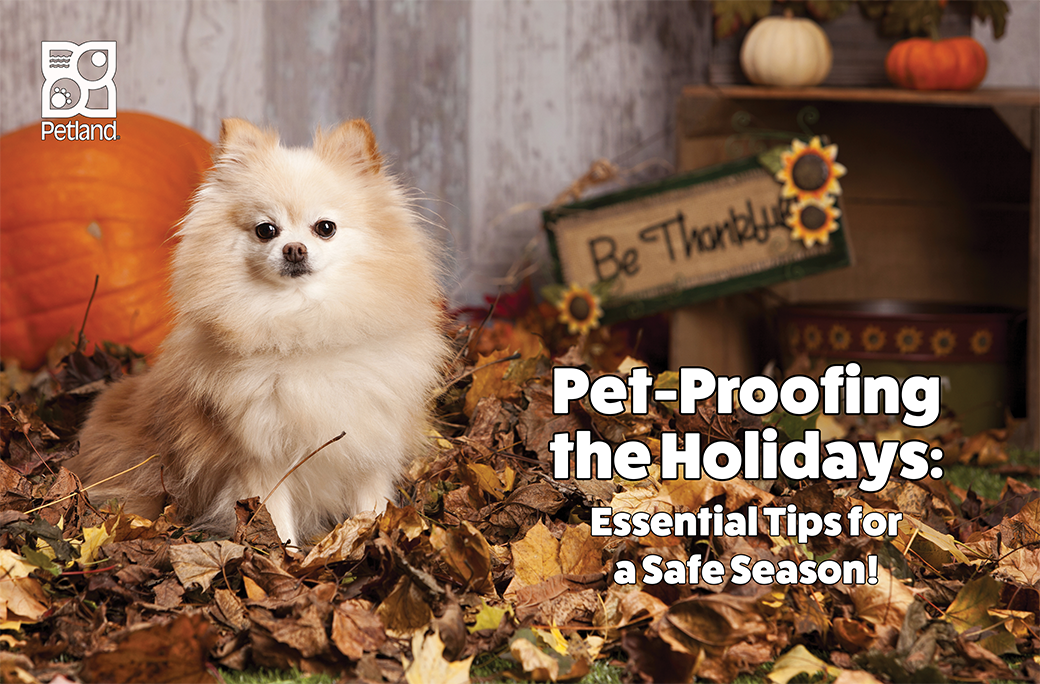As we near Thanksgiving and Halloween, it's time to think about ways that we can keep our pets safe during all of the festivities. There is a lot of partying during the fall, and if you have dogs or cats, chances are they will be very interested in your guests and even more in the food and decorations. Here are a few tips to keep your pets safe during this fall!
Thanksgiving
Here are some tips to celebrate the day of giving thanks.
- Don’t feed your dog or cat leftovers from your turkey. Plain turkey is not toxic for pets and can even be part of your pet’s regular diet. But most people don’t eat plain turkey for Thanksgiving. We rub it with butter, oil, and spices and stuff it with garlic, onions, and other delicious—to us—ingredients. But some herbs, onion and garlic are very toxic to pets, causing at best digestive upset and at worst pancreatitis.
- Don’t feed any bones to your pet, especially poultry bones which are brittle and can splinter and cause mouth wounds, throat wounds, and punctured stomachs or intestines. They can also cause blockages or choking.
- Cornucopias filled with fresh fruit can also be hazardous. Grapes in particular are especially toxic to pets and can cause death (so can raisins and currants). Citrus fruits can cause digestive upset, and virtually all seeds and pits of fruit are toxic. While dogs love apples and bananas, which are fine for them to eat, be careful that these fruits haven’t been around long enough to contain mold. Dried fruits such as strawberries, mango, pineapple, and apricots contain concentrated amounts of sugar, so they should be fed sparingly.
- Pumpkins, corn stalks, potted chrysanthemums and dried corn are decorations cats can’t seem to resist. But mums are toxic and the other decorations can be choking hazards or cause choking or intestinal blockages, so consider artificial substitutes that are not so alluring to cats.
Halloween
When the kiddos dress up in Halloween costumes, we like to dress our pets up, too. That’s fine, because there are so many pet-safe costumes for your pets to don (check out some of our favourite Halloween costumes here!) However, decorations and Halloween treats can be toxic when ingested by animals, so here are a few reminders.
- The biggest hazard for pets on Halloween is from eating candy. All chocolate—especially dark chocolate—contains theobromine, a substance that, depending upon the amount, can cause digestive upset or even death. And don’t think other candies are okay. Sugar in the amounts humans consume is very bad for pets. Sugar-free doesn’t cut it, either, because artificial sweeteners—especially Xylitol, which can cause kidney failure and death in pets—are bad for your furry buddies, too.
- Candy wrappers can become blockages in your dog or cat’s digestive tract, necessitating surgery. Some pets are quick to gobble up the wrappers because they smell like candy.
- Some pets find spider web decorations enticing. Cats can get entangled in them, and all pets may chew on them, once again risking blockages.
- Corn decorations and balloons both pose hazards for pets. Pets can choke on them or inhale them as well as the risk of intestinal blockages.
- Jack-o-lanterns can be hazardous to your pet, but not because they are pumpkins. Pumpkin is actually good for pets, but not in the form of carved decorations. Unrefrigerated, cut pumpkin quickly develops mold and large chunks of pumpkin with the outer shell are possibly deadly. Keep them outside on your porch and well out of the reach of pets. Of course, it goes without saying that untended candles are always dangerous!
Other decorations that can cause problems are listed here.
- Candles are a no-brainer. Singed whiskers and tails are the least of the problems, as pets can easily knock them over and start a fire. We recommend battery-operated candles for a warm, inviting glow.
- Lights. Fortunately, strings of lights are going out of fashion as pre-lighted trees with LED lights become more affordable. When pets chew on electric cords or strings of lights, not only are they at risk of electrocution, the damaged cords can start a fire.
With a little common sense and forethought, decorating your house for the holidays can be fun, festive, and safe for your pets. Happy fall!



